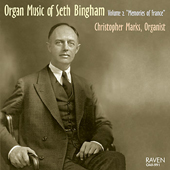
ESSENTIAL RECORDINGS

1- Harmonies of Florence, Op. 27
- Florentine Chimes
- Primavera
- Savonarola
- Twilight at Fiesole
- March of the Medici
2- Memories of France, Op. 16
- Carillon de Chateau-Thierry
- Pastorale, or Love in the Fields
- Mid-Lent in Paris
3- Sailing Over Jordan
4- Annunciation
5- Nativity Song
6- At the Cradle of Jesus
7- Hymn Fantasy on "Riverton"
8- Ut Queant Laxis, Op. 61
American organist Seth Bingham (1882-1972) was also a prolific and creative
composer of chamber music, orchestral works, vocal and choral settings, and of course, impressive
and imaginative organ pieces. His works definitely fit within the category of musical compositions to
be performed on the pipe organ, and not music written for the organ. It may not be obvious, but
there is a major difference between the two. These are more like orchestral pieces played by a
one-man-band, the organist. These are pieces worked out in the mind before being applied to the
instrument. It is up to the organist, when performing such works, to unearth and decipher their
deeper inner musical narrative, and with an intuitive and thoughtful application of the organ's stops,
deliver an interpretation that well reveals the music's intent.
As illustrated by the opening Florentine Chimes, organist
Christopher Marks is well aware of this, and in this piece as in all the others, uses a varied
registration that always clearly defines the individual melodic lines as well as conveying the work's
main character. I know that some composers annotate and impose their own sets of stops on their
scores, but I have a feeling this is not the case here. And despite the fact that the 1997
Schoenstein and Co., Op. 126 Organ of the First Plymouth Congregational Church in
Lincoln Nebraska is a monster of an instrument, Christopher Marks never uses it
solely to impress, but rather to serve the music first and foremost. Twilight at Fiesole
is another great example of a judicious use of this organ's capabilities, by the proper
use of soft stops, chimes and bells, to convey the music's descriptive nature. Mid-Lent
in Paris (probably the composer's tongue in cheek nod at Springtime in Paris) incorporates
a melody that sounds like it should be played by a French café accordion. And one of the last pieces
that Bingham composed, the Ut Queant Laxis, Op. 61 displays his
ability to build an impressive work out of a simple hymn tune, and slowly develop its layers until
it requires the organ's full splendour on the final chord.
Music by a composer that had a voice all his own but remained within the boundaries set by tonality,
who had a deep respect for tradition, and always had a strong grasp of the organ's limits and potential,
and used them accordingly. Raven's previous Volume 1 release of this composer's
organ music was very well received, and this new recording should fare just as well.
Jean-Yves Duperron - March 2011